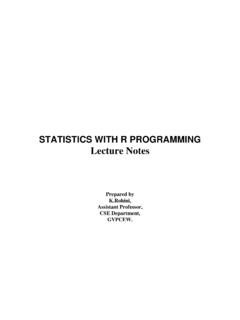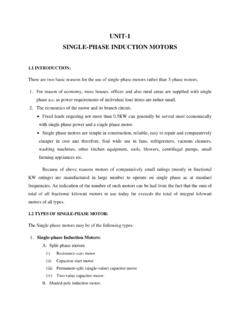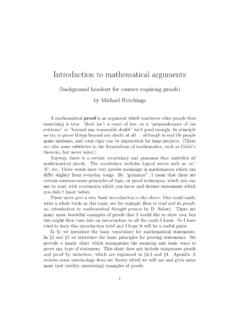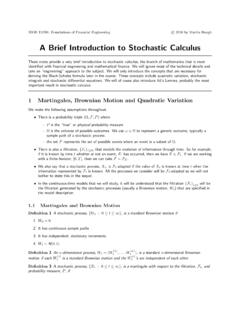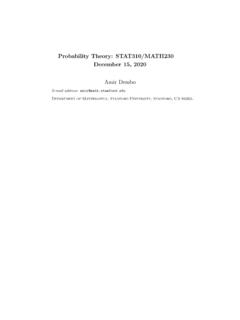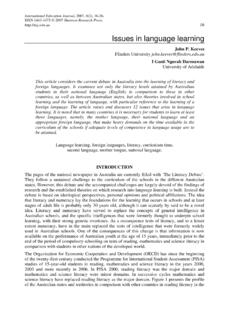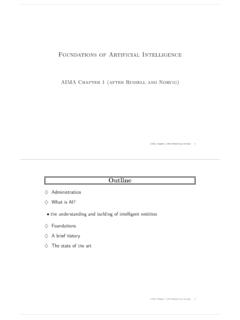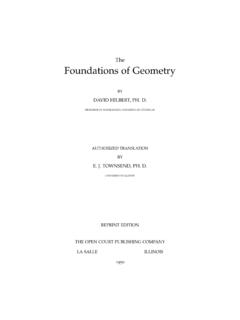Transcription of MATHEMATICAL FOUNDATIONS OF COMPUTER SCIENCE
1 1 LECTURE NOTES ON MATHEMATICAL FOUNDATIONS OF COMPUTER SCIENCE II B. Tech I semester (JNTUK-R16) Mr. Assistant Professor DEPARTMENT OF MATHEMATICS GAYATRI VIDYA PARISHAD COLLEGE OF ENGINEERING FOR WOMEN VISAKHAPATNAM-530048 2 SYLLABUS UNIT -I: MATHEMATICAL Logic: Propositional Calculus: Statements and Notations, Connectives, Well Formed Formulas, Truth Tables, Tautologies, Equivalence of Formulas, Duality Law, Tautological Implications, Normal Forms, Theory of Inference for Statement Calculus, Consistency of Premises, Indirect Method of Proof. Predicate Calculus:Predicative Logic, Statement Functions, Variables and Quantifiers, Free and Bound Variables, Inference Theory for Predicate Calculus.
2 UNIT -II: Set Theory: Introduction, Operations on Binary Sets, Principle of Inclusion and Exclusion, Relations: Properties of Binary Relations, Relation Matrix and Digraph, Operations on Relations, Partition and Covering, Transitive Closure, Equivalence, Compatibility and Partial Ordering Relations, Hasse Diagrams, Functions: Bijective Functions, Composition of Functions, Inverse Functions, Permutation Functions, Recursive Functions, Lattice and its Properties. UNIT- III: Algebraic Structures and Number Theory: Algebraic Structures: Algebraic Systems, Examples, General Properties, Semi Groups and Monoids, Homomorphism of Semi Groups and Monoids, Group, Subgroup, Abelian Group, Homomorphism, Isomorphism, Number Theory: Properties of Integers, Division Theorem, The Greatest Common Divisor, Euclidean Algorithm, Least Common Multiple, Testing for Prime Numbers, The Fundamental Theorem of Arithmetic, Modular Arithmetic (Fermat s Theorem and Euler s Theorem) UNIT -IV: Combinatorics.
3 Basic of Counting, Permutations, Permutations with Repetitions, Circular Permutations, Restricted Permutations, Combinations, Restricted Combinations, Generating Functions of Permutations and Combinations, Binomial and Multinomial Coefficients, Binomial and Multinomial Theorems, The Principles of Inclusion Exclusion, Pigeonhole Principle and its Application. UNIT -V: Recurrence Relations: Generating Functions, Function of Sequences, Partial Fractions, Calculating Coefficient of Generating Functions, Recurrence Relations, Formulation as Recurrence Relations, Solving Recurrence Relations by Substitution and Generating Functions, Method of Characteristic Roots, Solving Inhomogeneous Recurrence Relations UNIT -VI: Graph Theory: Basic Concepts of Graphs, Sub graphs, Matrix Representation of Graphs.
4 Adjacency Matrices, Incidence Matrices, Isomorphic Graphs, Paths and Circuits, Eulerian and 3 Hamiltonian Graphs, Multigraphs, Planar Graphs, Euler s Formula, Graph Colouring and Covering, Chromatic Number, Spanning Trees, Algorithms for Spanning Trees (Problems Only and Theorems without Proofs). TEXT BOOKS: MATHEMATICAL Structures with Applications to COMPUTER SCIENCE ,J. and P. Manohar,Tata McGraw Hill. 2. Elements of Discrete Mathematics-A COMPUTER Oriented Approach, C. L. Liu and D. P. Mohapatra, 3rdEdition, Tata McGraw Hill. 3. Discrete Mathematics and its Applications with Combinatorics and Graph Theory, K.
5 H. Rosen, 7th Edition, Tata McGraw Hill. REFERENCE BOOKS: 1. Discrete Mathematics for COMPUTER Scientists and Mathematicians, J. L. Mott, A. Kandel, Baker, 2nd Edition, Prentice Hall of India. 2. Discrete MATHEMATICAL Structures, BernandKolman, Robert C. Busby, Sharon Cutler Ross, PHI. 3. Discrete Mathematics, S. K. Chakraborthy and Sarkar, Oxford, 2011. 4 Unit I MATHEMATICAL Logic INTRODUCTION Proposition: A proposition or statement is a declarative sentence which is either true or false but not both. The truth or falsity of a proposition is called its truth-value. These two values true and false are denoted by the symbols T and F respectively.
6 Sometimes these are also denoted by the symbols 1 and 0 respectively. Example 1: Consider the following sentences: 1. Delhi is the capital of India. 2. Kolkata is a country. 3. 5 is a prime number. 4. 2 + 3 = 4. These are propositions (or statements) because they are either true of false. Next consider the following sentences: 5. How beautiful are you? 6. Wish you a happy new year 7. x + y = z 8. Take one book. These are not propositions as they are not declarative in nature, that is, they do not declare a definite truth value T or F. Propositional Calculus is also known as statement calculus. It is the branch of mathematics that is used to describe a logical system or structure.
7 A logical system consists of (1) a universe of propositions, (2) truth tables (as axioms) for the logical operators and (3) definitions that explain equivalence and implication of propositions. Connectives The words or phrases or symbols which are used to make a proposition by two or more propositions are called logical connectives or simply connectives. There are five basic connectives called negation, conjunction, disjunction, conditional and biconditional. Negation The negation of a statement is generally formed by writing the word not at a proper place in the statement (proposition) or by prefixing the statement with the phrase It is not the case that.
8 If p denotes a statement then the negation of p is written as p and read as not p . If the truth value of p is T then the truth value of p is F. Also if the truth value of p is F then the truth value of p is T. Table 1. Truth table for negation p p T F F T 5 Example 2: Consider the statement p: Kolkata is a city. Then p: Kolkata is not a city. Although the two statements Kolkata is not a city and It is not the case that Kolkata is a city are not identical, we have translated both of them by p. The reason is that both these statements have the same meaning. Conjunction The conjunction of two statements (or propositions) p and q is the statement p q which is read as p and q.
9 The statement p q has the truth value T whenever both p and q have the truth value T. Otherwise it has truth value F. Table 2. Truth table for conjunction p q p q T T F F T F T F T F F F Example 3: Consider the following statements p : It is raining today. q : There are 10 chairs in the room. Then p q : It is raining today and there are 10 chairs in the room. Note: Usually, in our everyday language the conjunction and is used between two statements which have some kind of relation. Thus a statement It is raining today and 1 + 1 = 2 sounds odd, but in logic it is a perfectly acceptable statement formed from the statements It is raining today and 1 + 1 = 2.
10 Example 4: Translate the following statement: Jack and Jill went up the hill into symbolic form using conjunction. Solution: Let p : Jack went up the hill, q : Jill went up the hill. Then the given statement can be written in symbolic form as p q. Disjunction The disjunction of two statements p and q is the statement p q which is read as p or q . The statement p q has the truth value F only when both p and q have the truth value F. Otherwise it has truth value T. Table 3: Truth table for disjunction p q p q T T T T F T F T T F F F Example 5: Consider the following statements p : I shall go to the game.
